Menus
- Sports tourer in the 50,000 km test
- The Honda CBR 600 F is actually a sporty Hornet 600
- The Honda CBR 600 F was by no means spared in the MOTORRAD endurance test.
- The Honda CBR 600 F is the new front runner in the MOTORCYCLE endurance test statistics
- Balance after 50,000 kilometers
- Honda takes a stand
- Honda CBR 600 F: cost and maintenance
- Operating costs of the Honda CBR 600 F over 50,000 kilometers
- Maintenance and repairs (according to the specified mileage)
- Tire tips for the Honda CBR 600 F
- Bridgestone BT 023
- Bridgestone S 20
- Conti Road Attack 2
- Dunlop Roadsmart 2
- Metzeler Roadtec Z8 M / O
- Michelin Pilot Road 3
- Pirelli Angel ST
- Reader experiences
- Used Honda CBR600F in Germany
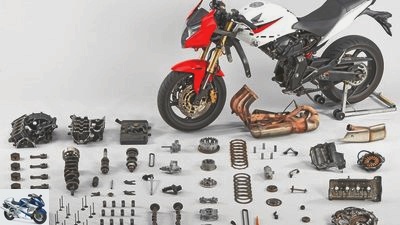
Bilski

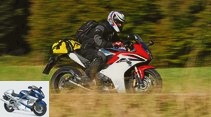
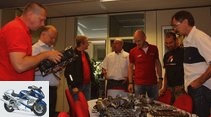
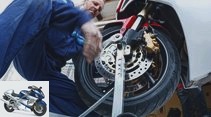
25th photos
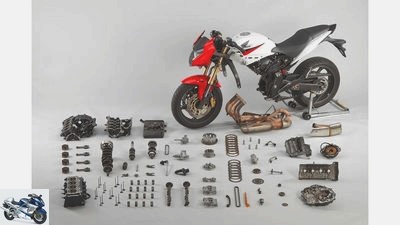
Bilski
1/25
The Honda CBR 600 F is a plain, but rock solid motorcycle with the nimbus of indestructibility.
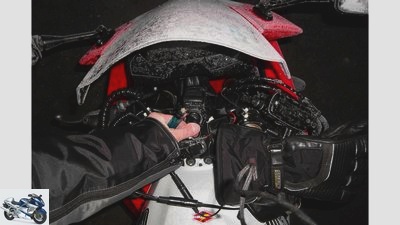
Bilski
2/25
You really can’t blame the CBR for that: The ignition lock was frozen at temperatures below minus ten degrees – but starting was no problem after thawing.
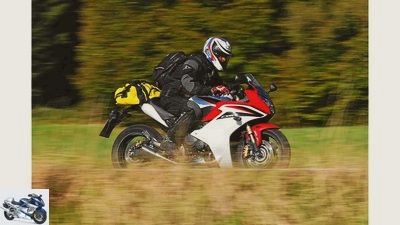
Bilski
3/25
Finally on the move: Only with the luggage it was quite tight on a long tour.

Bilski
4/25
Honda employees Guido Nowak, Jurgen Hopker and Oliver Franz (in red from left) discuss with MOTORRAD editors.
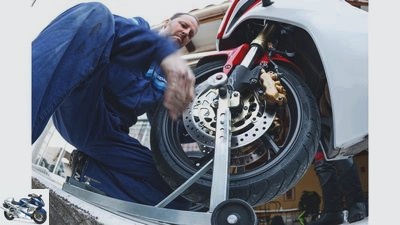
Bilski
5/25
With three endurance testers, including the CBR 600 F, MOTORRAD went to southern France last winter to test tires. Mechanic Stefan Gluck now changes wheels in his sleep.

Bilski
6/25
Bridgestone BT 023: On cool days they require careful warm kneading in order to become supple and grippy. But then the BT 023 turn out to be a set of tires that harmonizes very well with the CBR 600 F. Neutral steering behavior and low pitching moment when braking are its strengths, the grip is good, as is the maneuverability.
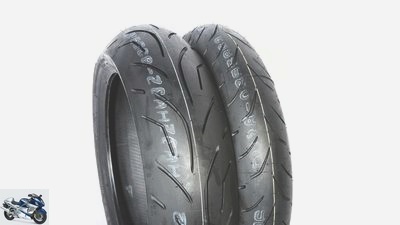
Bilski
7/25
Bridgestone S 20: A stunner for sporty drivers. Even on cool days and when it is wet, the S 20 is “fully there” after just three turns. Wonderfully easy turning and good grip encourage you to let it go. The increased driving dynamics, however, begin to overwhelm the shock absorber; especially the hindquarters pumps when driving sharply.
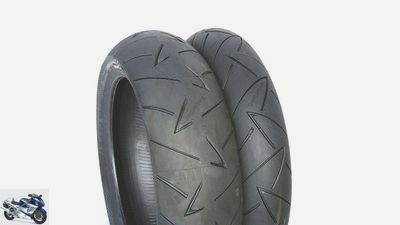
Bilski
8/25
Conti Road Attack 2: Another sporty set of tires, which does not roll as comfortably as the S 20. From the front you can feel the bumps exactly; you can also call that clear feedback. The CBR 600 F easily steers into the road attack and the grip is very good when it is warm. Righting moment when braking in an inclined position bearable.

Bilski
9/25
Dunlop Roadsmart 2: The Dunlops need the longest warm-up phase of all the tires tested, do not turn in as easily and show a slightly stronger righting moment than average when braking in an inclined position. They ensure neutral steering behavior over the entire lean angle and, when warm, provide very good grip.
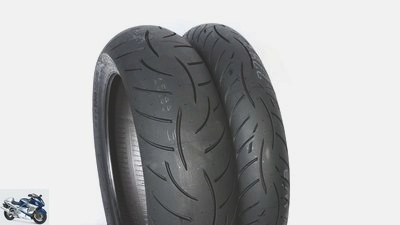
Bilski
10/25
Metzeler Roadtec Z8 M / O: They are among those tires that start up immediately, even when new and cold, and instill confidence spontaneously. With the Z8, the CBR turns comfortably easily, without ever looking wobbly. Thanks to good self-damping, they roll off comfortably; only the righting moment when braking in an inclined position is a tad too clear. Still: great touring tires.

Bilski
11/25
Michelin Pilot Road 3: Those who like it particularly handy are best served by the Michelin combination. However, the price for the feather-light turning and the possibility of driving the tightest lines has to be paid in the deepest lean angle. Here the machine tilts into the curve. In addition, the tires do not show when they are approaching the limit, so a lot of feeling is required.
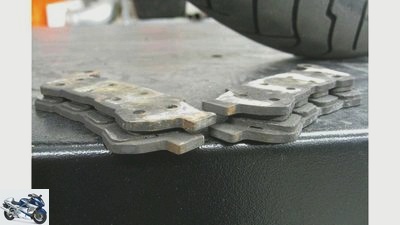
Bilski
12/25
The front brake pads wear differently in the two calipers. The Honda composite brake CBS certainly plays a role, because the calipers are loaded differently.

Bilski
13/25
Washouts in the connecting rod bearing shells.
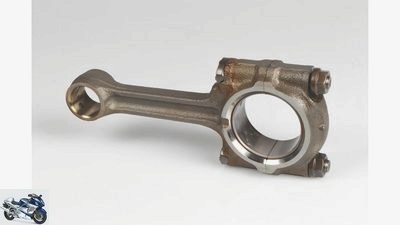
Bilski
14/25
The cause of the unusual washouts in the connecting rod bearing shells remained unclear. The wear measurements were perfect, so they appear harmless.
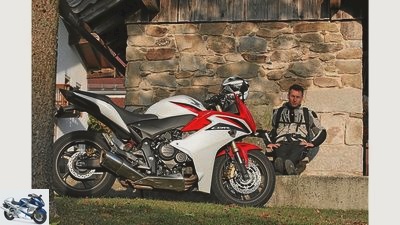
Bilski
15/25
What is Sven thinking about here? Maybe over the roar of the disguise.
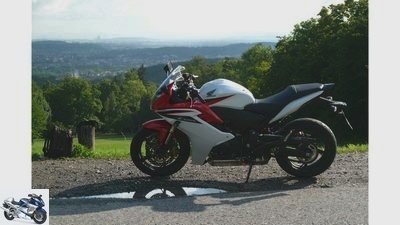
Bilski
16/25
Steadfast: The CBR is shown quite often in photos, but otherwise it was often moved with pleasure.

Bilski
17/25
The piston and cylinder show only minimal signs of wear. A few small scratches are completely insignificant, the parts could in any case continue to be used without replacement.
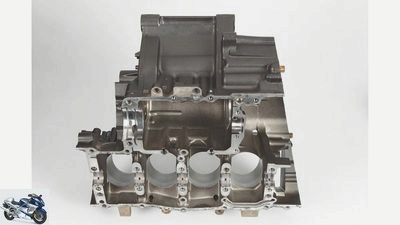
Bilski
18/25
The four-cylinder is very compact, the cylinders are integrated in the upper part of the housing. If the raceways were worn, the housing would also be ruined.
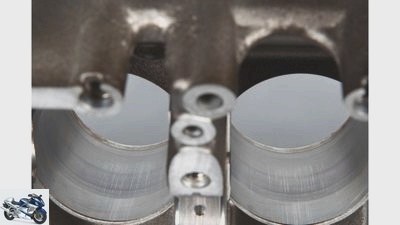
Bilski
19/25
The cylinder liners.
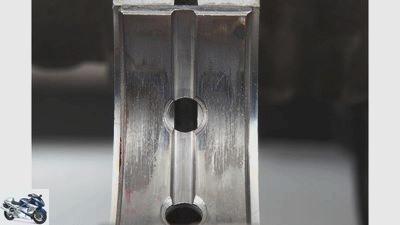
Bilski
20/25
The bearing shells of the crankshaft also show only slight running marks and would certainly last a long time. When rebuilding it would still be advisable to renew it.
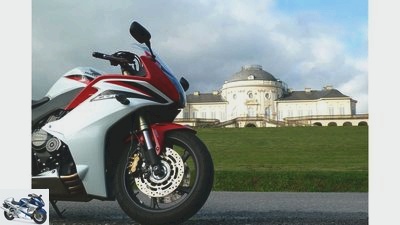
Bilski
21/25
There it is again: a decorative photo in between, then we drove again.
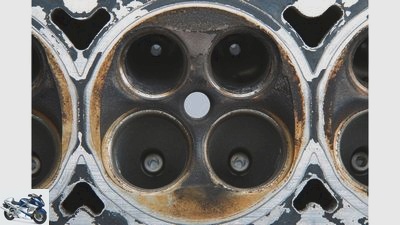
Bilski
22/25
Few scorch marks, hardly any oil carbon and narrow valve seats result in high compression and no loss of performance. The small individual cubic capacities of the four-cylinder lead to clean combustion.
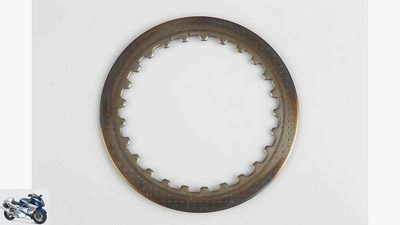
Bilski
23/25
The clutch disks are heavily loaded on test machines, test drives for driving performance can be the cause of tarnished steel disks.
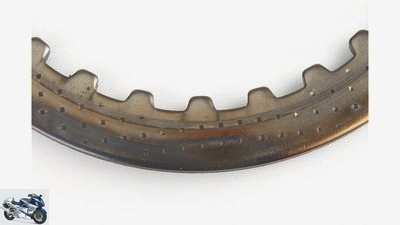
Bilski
24/25
Close-up of the tarnished clutch disc.
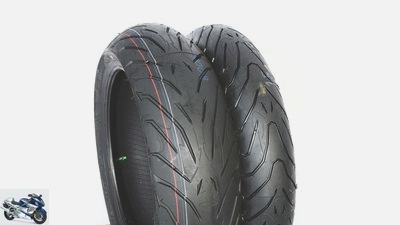
Bilski
25/25
Pirelli Angel ST: Harmonious steering behavior is the strength of the two angels. With them covered in tires, the CBR behaves neither wobbly nor too sluggishly over the entire lean angle range. However, the Pirelli pairing feels a bit spongy in deep slopes. Nevertheless, one gets the impression that the front tire is rolling a little too hard.
Endurance test final balance Honda CBR 600 F
Sports tourer in the 50,000 km test
What the tough MOTORCYCLE endurance test over 50,000 kilometers showed is by no means bitter: namely, that the Honda CBR 600 F is an honest, but rock solid motorcycle with the aura of indestructibility. But it was really nothing?
W.hen Japanese engine technicians have mastered anything, it is the in-line four-cylinder. They did not invent it in principle, but made it ready for mass production and perfected it. And that is especially true for Honda, who laid the foundation for this success story in 1969 with the legendary CB 750. A four-breasted suit from Honda – nothing can go wrong.
Buy complete article
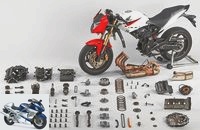
Endurance test final balance Honda CBR 600 F
Sports tourer in the 50,000 km test
CBR 600 F actually not a Japanese machine at all. It was certainly developed in the Far East, but like its base, the Hornet 600, it will be built in Atessa, Italy. According to Japanese standards, of course. The endurance test should also prove, among other things, whether these are also complied with in Europe.
However, the new addition to the long-term test fleet was not necessarily received with storms of enthusiasm. The Honda CBR 600 F was there at some point and it was carefully noted. But gradually even performance-spoiled testers came to appreciate the little sporty all-rounder. The Honda CBR 600 F was practically permanently in use, was driven a lot and also far. Within a short time, the kilometers on the clock increased.
The Honda CBR 600 F turned out to be a handy, undemanding machine that impresses with its high level of suitability for everyday use. “Typically Honda: sit on, feel good – fits,” comments Gerhard Eirich from “MOTORRAD Classic”. The managing editor Harry Humke praises the Honda CBR 600 F as “uncomplicated everyday athlete that is just fun”.
On the whole, the qualities of the well-behaved all-rounder Honda CBR 600 F are recognized, but with increasing kilometers on the speedometer there were also some less friendly comments in the logbook. “Boredom in shape,” comments tester Andi Bildl. “Colorless BBB”, writes “PS” man Rob Gluck and means “bread and butter bike”. Colleague Thomas Schmieder differentiates: “like a VW Golf on wheels: practical, inconspicuous, personable – but also not very emotional”.
Well, whether a machine grabs someone emotionally or not, is certainly a matter of taste and individually quite different. But apart from subjective expressions of opinion, tangible factual criticism was voiced here and there from the start. Although it was never about substantial problems with the Honda CBR 600 F, there were still some minor annoyances that stood out and bothered one or the other.
The high idle speed after a cold start, which the Honda CBR 600 Fin tries to push into the corners during the warm-up phase, is particularly annoying in daily short journeys. “Why does it have to cheer up to 2000 revs after a cold start?” Asks Thomas Schmieder. “The neighbors are already looking in the morning.” The era of high-revving carburetor engines with the choke turned on seemed to have long since been overcome; modern motorcycles with complex injection management should better master this discipline.
The Honda CBR 600 F is actually a sporty Hornet 600
Bilski
What is Sven thinking about here? Maybe over the roar of the disguise.
The tourists among the drivers complained about the inadequate luggage storage on the Honda CBR 600 F and criticized the tingling vibrations at medium speeds, which in the long term led to numb fingertips at the recommended speed on the motorway. And the somewhat hooked gearshift did not appear to be quite Honda-like to some testers.
There was also unanimous and bitter criticism of the instrumentation of the Honda CBR 600 F: The digital displays are generally difficult to read, this applies primarily to the typical Honda bar display of the rev counter, which is barely visible in daylight. And if it does, then the current speed cannot be identified due to the lack of clear scaling. It seems strange that Honda is incorporating this unrealistic bar display into a whole range of models today. Okay, information about the current speed may be dispensable, but not about the current speed, which is also difficult to see in some lighting conditions.
After all, the pale displays of the Honda CBR 600 F are easier to see at night, but then the glaring high beam indicator light dazzles the driver. It shines brighter than the high beam itself, say cynics, because it only shines diffusely into nothing – with a lot of scattered light directly in front of the front wheel instead of a far-reaching cone. Some colleagues therefore simply left the low beam on in the dark.
When assessing the quality of the chassis, it should be noted that the current Honda CBR 600 F (internal code PC41) has little in common with the model of the same name (PC35) built up to 2006, and certainly not with the current CBR 600 RR (PC40). The PC41 certainly does not want to be a real super sports car, even if it is powered by a four-wheeler derived from the sportsman. Technically, the current Honda CBR 600 F is basically nothing more than a 600 Hornet in sporty clothing, i.e. a cheaper and less expensive mid-range all-rounder. This is the only way to achieve a good price, says the manufacturer.
Certainly a strategically correct measure, because the market for super sports cars in general – and that of the 600 series in particular – has collapsed in recent years. At Honda, sales of the Doppel-R dropped from a good 1200 machines to 275 in 2012 within five years, so the 744 (2011) and 563 (2012) CBR 600 F machines delivered by Honda Germany came at just the right time.
Sports freaks shouldn’t set their expectations too high, as the first Honda CBR 600 F was when it was introduced in 1986, it is no longer a hit in the current environment. This applies, for example, to the spring elements, which offer adjustment options, but are much simpler than the complex parts in the super sports cars. However, this is by no means negatively reflected in driving comfort; on the contrary, many drivers praised the clean response of the upside-down fork. With heavy loads, however, there are fewer reserves. And here and there the fork deals metal-hard blows when driving over edges.
When it’s not about chasing the best times, the little Honda can also be a lot of fun on the racetrack. Her colleague Eva Breutel kidnapped the long-term test Honda CBR 600 F to a training session for the MOTORRAD action team on the Nordschleife and was extremely satisfied: “Light, easy to handle, doesn’t bother you – ideal for sniffing around”. But whether on the racetrack or on the road, good tires are always a decisive factor. Especially since the Honda CBR 600 F reacts quite clearly to the type and condition of the tires. With certain tires it can develop a stubborn life of its own, with others it runs neutrally and precisely. The standard Bridgestone BT 012 tires are definitely not the best, as there are alternatives with better manners.
But we come to the core competence of the 600 four-cylinder, namely reliability and stability. As expected by many, the endurance test machine was not at fault in any of these points. During the entire 50,000 kilometers there was not a single breakdown, no breakdowns or defects that forced unscheduled visits to the workshop.
The Honda CBR 600 F was by no means spared in the MOTORRAD endurance test.
Bilski
The ignition lock was frozen at below -10 ° C. After thawing, the Honda CBR 600 F started without any problems.
The higher wear of the brake pads on the left caliper was possibly due to the CBS composite brake of the Honda CBR 600 F. It could also have something to do with the fact that the pistons ran a little harder and so the pads wore out. That was noticed by Harry Humke, who noted at the kilometer reading of 24,000: “The brake slips when pushing.” While the pads on the right were only replaced once, this had to happen twice on the left. Incidentally, the two linings on the rear pliers also wore out unevenly at times.
Maybe tough operating conditions were a little involved. In any case, the Honda CBR 600 F was not spared, because of its reliability it was often used even in the worst weather conditions in the cold season. The fact that fleet manager Rainer Froberg froze the ignition lock at temperatures of minus ten degrees overnight is certainly not her fault. After the key was heated with the lighter, the problem was quickly solved. In any case, the Honda CBR 600 F always went into service without any problems, even after such a frosty overnight stay outdoors.
In terms of reliability, the Honda CBR 600 F lived up to its reputation. But what about the processing? Are there qualitative differences between “Japanese” and “Italian” Hondas? A question that can hardly be answered universally. Obvious defects in processing are in any case not recognizable in the case of the CBR. The otherwise solid impression was clouded by the constant roaring noises from the paneling, the cause of which could not be clarified. There was this uncomfortable rattling especially in the range around 4000 rpm, where the engine runs quite rough.
The first entries on this topic can be found in the driver’s log from a mileage of 10,000, before it wasn’t there or nobody noticed. It remains unclear whether these booming noises were the result of the aging process, assembly errors after inspections or a harmless fall over while standing still after 3750 kilometers. In any case, there was nothing broken on the panel, no cracks, no missing screws, no broken noses.
Apart from that, the Honda CBR 600 F still makes a decent impression after a good two years of long, hard winters. Painted and metal surfaces work perfectly. Without corrosion or chipping, there is no rust at all, screws and nuts are obviously of impeccable Japanese (or Italian?) Quality.
The Honda CBR 600 F is the new front runner in the MOTORCYCLE endurance test statistics
Bilski
The four-cylinder of the Honda CBR 600 F is very compact, the cylinders are integrated in the upper part of the housing.
But what does it look like inside the engine? This is only shown at the end of the endurance test, when the motorcycle is torn apart in the workshop. Before that, however, engine and driving performance were measured according to the usual procedure. Surprisingly, the four-cylinder has not decreased a bit after 50,000 kilometers, and even increased its power a little on the test bench. Workshop boss Gerry Wagner looked at the compression diagram in astonishment: All four cylinders showed exactly the same value as at the beginning of the endurance test, which is not seen every day.
And it already suggests that the inner workings of the Honda CBR 600 F must have survived the 50,000 kilometers in excellent condition. This applies in particular to the performance-determining parts, i.e. the piston / cylinder and valve train. And indeed, all of these components are in perfect condition. Typically Japanese four-cylinder, one would say, even if the engine is assembled in Italy.
No more than a side note are superficial washouts on the lower connecting rod bearings – perhaps as a result of cavitation (blistering under high pressure), but which are in no way a cause for concern, especially since the wear dimensions of all bearings are within the installation tolerance. Discoloration on the steel plates of the clutch indicates that the Honda has been pounded hard on occasion. The clutch and gearbox also look great, the otherwise often sharpened shift forks are almost new. Then you have to talk about such little things as the rear wheel bearings, which because of their slightly increased play, might soon be ripe for a swap.
All of this makes the Honda CBR 600 F the new front runner in the MOTORCYCLE endurance test statistics. With a one-point lead, it just trumps the previous leader, the Harley-Davidson Road King. The outstanding stability of the engine contributes to this, and the CBR 600 F also proves to be an inexpensive machine in terms of maintenance costs. This is also because it was already one of the Honda models that, unlike older machines, were converted to the longer inspection intervals of 12,000 kilometers.
The fuel costs are kept within reasonable limits, but a consumption of 5.8 liters per 100 kilometers is not outstanding for a mid-range machine. A particularly high speed requires a clear express surcharge, but the minimum consumption is by no means record-breaking.
There is one point where the Honda CBR 600 F cannot hold a candle to the Road King: The percentage loss in value is much higher than that of the stable Harley. But what is put into perspective by the new price: Absolutely less is lost, because with currently just under 9,000 euros, the Honda costs less than half as much as the Harley.
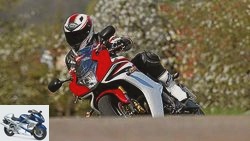
Tourer
Top test: Honda CBR 600 F
Mid-range sports tourer from Honda in the test
read more
Balance after 50,000 kilometers
Bilski
The piston and cylinder of the Honda CBR 600 F show only minimal signs of wear. Some small scratches are completely insignificant.
In seldom harmony: the four cylinders paint beautiful lines of equal length on the paper of the compression measuring device – both at the beginning and at the end of the endurance test.
Cylinder head:
Some exhaust valves are leaking slightly, but the compression has not decreased. The valve guides and stems are in very good condition, as are the camshafts and bearings. The exhaust valve seats and valves have minor scorch marks.
Cylinder / piston:
The cylinders and pistons show hardly any signs of wear apart from a few harmless traces of friction, as do the piston rings.
Crank drive:
Slight traces of cavitation are visible on the connecting rod bearings, but the bearing play is still within the installation tolerance. The crankshaft main bearings show an inconspicuous contact pattern, the bearing play is slightly increased. Piston pins and connecting rod eyes are also in good condition.
Power transmission:
The gear wheels and shafts as well as the switching mechanism show hardly any signs of wear. The clutch steel disks are discolored, but not warped. The clutch springs have settled a bit.
Frame / chassis:
The frame and add-on parts show signs of wear corresponding to the mileage, the swing arm and steering head bearings are free of play, only the rear wheel bearings have increased play.
Honda takes a stand
Bilski
Honda employees Guido Nowak, Jurgen Hopker and Oliver Franz (in red from left) discuss with MOTORRAD editors.
Is there an explanation for different (left / right brake caliper) worn brake pads on the front wheel of the Honda CBR 600 F.?
Because of the compound brake, the single CBS, the left caliper is more stressed when only the front brake lever is operated. All three pistons then act in the left tong, in the right only two. It is therefore entirely possible that the wear is uneven.
How does the unusual wear and tear on the lower connecting rod bearings come about?
The superficial washings are certainly harmless, we don’t have an explanation either.
Which parts should be replaced now??
The engine would certainly be good for the same distance again without exchanging parts.
At the end of the endurance test, there was increased play on the rear wheel bearings.
On the one hand, it depends on the weather conditions in which the vehicle was moved. If you drive a lot in the rain or in winter, a wheel bearing wears out faster. On the other hand, a chain that is tensioned too tightly can lead to increased stress and wear.
When starting from cold, the engine revs quite high (2000 rpm), why is that??
The reason for this is the current legislation regarding exhaust gas values. The increased idling speed at the beginning ensures that the engine and catalytic converter warm up more quickly – and thus a shorter cold-running phase. Furthermore, the catalytic converter responds faster.
Test drivers complained about vibrations that led to booming noises from the fairing. Why does the four-cylinder run so rough?
All Honda four-cylinder units in the 600 cubic centimeter range have this running property, and consequently this possible tendency to vibrations. The booming noises especially on the fairing of the Honda CBR 600 F can be switched off – Honda supplies a kit for this. (Rubber parts for lining.)
The spring elements seem a bit weak, the fork in particular sometimes hits quickly and hard. Is the chassis of the Honda CBR 600 F changed compared to the Hornet?
No, they are the same.
Honda CBR 600 F: cost and maintenance
Bilski
Steadfast: The CBR is shown quite often in photos, but otherwise it was often moved with pleasure.
Operating costs of the Honda CBR 600 F over 50,000 kilometers
14 liters of oil at 17.90 euros – 250.60 euros
5 oil filters at 14.29 euros – 71.45 euros
1 air filter – 56.40 euros
8 spark plugs at 16.10 euros – 128.80 euros
2 sets of rear brake pads at 68.19 euros – 136.38 euros
3 sets of front brake pads at 48.51 euros – 145.53 euros
2 chain sets – 373.90 euros
Brake fluid – 9.94 euros
Small parts, lubricants – 60.57 euros
Seals – 8.58 euros
Inspections and repairs – 1441.24 euros
Tires (including assembly, balancing and disposal) – 1452.00 euros
Fuel – 4693.25 euros
Total cost – 8828.64 euros
Acquisition cost – 9160.00 euros
Loss of value – 4110.00 euros
Estimated price (dealer selling price) – 5050.00 euros
Cost per kilometer (without depreciation) – 17.7 cents
Cost per kilometer (with depreciation) – 25.9 cents
Maintenance and repairs (according to the specified mileage)
Front and rear tires renewed, Michelin Pilot Road – 35741
Front and rear tires renewed, Conti Road Attack – 218 735
Chain set and rear brake pads renewed – 20 200
Front brake pads renewed – 24 322
Front and rear tires renewed, Dunlop Sportsmart – 229 174
Front and rear tires renewed, Bridgestone BT – 2340 734
Front left brake pads renewed – 43 552
Chain set renewed – 47 990
Rear brake pads renewed – 48 532
Tire tips for the Honda CBR 600 F
Bilski
Stefan Gluck now changes bikes in his sleep.
With three endurance testers, including the CBR 600 F, MOTORRAD went to southern France last winter to test tires. Mechanic Stefan Gluck now changes wheels in his sleep.
Bridgestone BT 023
Bilski
Bridgestone BT 023.
On cool days they require careful warm kneading in order to become supple and easy to grip. But then the BT 023 turn out to be a set of tires that harmonizes very well with the CBR 600 F. Neutral steering behavior and low pitching moment when braking are its strengths, the grip is good, as is the maneuverability.
Bridgestone S 20
Bilski
Bridgestone S 20.
A stunner for sporty drivers. Even on cool days and when it is wet, the S 20 is “fully there” after just three turns. Wonderfully easy turning and good grip encourage you to let it go. The increased driving dynamics, however, begin to overwhelm the shock absorber; especially the hindquarters pumps when driving sharply.
Conti Road Attack 2
Bilski
Conti Road Attack 2.
Also a sporty set of tires, but they don’t roll as comfortably as the S 20. Bumps can be felt from the front; you can also call that clear feedback. The CBR 600 F easily steers into the road attack and the grip is very good when it is warm. Righting moment when braking in an inclined position bearable.
Dunlop Roadsmart 2
Bilski
Dunlop Roadsmart 2.
The Dunlops need the longest warm-up phase of all the tires tested, do not turn in as easily and show a slightly stronger righting moment when braking in an inclined position than the average. They ensure neutral steering behavior over the entire lean angle and, when warm, provide very good grip.
Metzeler Roadtec Z8 M / O
Bilski
Metzeler Roadtec Z8 M / O.
They are among those tires that start up immediately, even when new and cold, and instill confidence spontaneously. With the Z8, the CBR turns comfortably easily, without ever looking wobbly. Thanks to good self-damping, they roll off comfortably; only the righting moment when braking in an inclined position is a tad too clear. Still: great touring tires.
Michelin Pilot Road 3
Bilski
Michelin Pilot Road 3.
Those who like it particularly handy are best served with the Michelin combination. However, the price for the feather-light turning and the possibility of driving the tightest lines has to be paid in the deepest lean angle. Here the machine tilts into the curve. In addition, the tires do not show when they are approaching the limit, so a lot of feeling is required.
Pirelli Angel ST
Bilski
Pirelli Angel ST.
Harmonious steering behavior is the strength of the two angels. With them covered in tires, the CBR behaves neither wobbly nor too sluggishly over the entire lean angle range. However, the Pirelli pairing feels a bit spongy in deep slopes. Nevertheless, one gets the impression that the front tire is rolling a little too hard.
Reader experiences
Verbena
Driver opinion: Thomas Eisentraut.
Stephanie Dahn, Bielefeld
I saw the first photo from the CBR in November 2010. It was love at first sight. In April she was finally there. It exceeded all of my expectations. My conclusion after two years and 12,000 kilometers: a great all-rounder with great handling, brakes and clutch are great. Whether I drive through the Sauerland on the weekend or take a brisk lap to the Koter Berg, it is a sporty motorcycle that you can do anything with. The good seating position means you can ride relaxed all day. The only drawback: When you are out in the mountains, you have to demand the CBR quite a bit. I always have to drive it in the higher speed range in order to get out of the bends quickly. 20 hp more would be desirable. Nevertheless, it is my dream bike.
Denise Schmidt, Berlin
Because of wallflowers! As you have already described in tests, the CBR is reliable and does what you expect: namely, work without any quirks. I was already traveling all over Germany with her this year and was able to test it – from Hamburg to Lorrach. It is quite tame and easy to turn into curves. It is also frugal: it covered 310 kilometers in a row on the autobahn and country road before the fuel gauge announced a reserve. In third gear it has a great pull, with which I was able to boil a Suzuki B-King during ADAC training. Small but nice! A small disadvantage: Due to the fairing, the CBR is somewhat prone to cross winds. And stowing luggage on the pillion seat isn’t easy either. Conclusion: very reliable, economical in consumption, patient with the driver. And you don’t even notice the 210 kg weight. The CBR is sporty, but still suitable for touring and also the right choice for not-too-tall drivers. From a purely visual point of view, it is an absolutely successful motorcycle for me anyway!
Thomas Eisentraut, Schleswig
I drove my PC41 over 12,000 kilometers from March to September 2012. Unfortunately, we parted ways due to a wildlife accident in which the machine was totaled and I suffered several broken bones. Positive: harmonious engine, good performance, low vibrations in the handlebars noticeable, generous 12,000 service intervals, seat is suitable for long journeys, good solution for attaching luggage (eyelets under the seat), low fuel consumption (average 5.1 l / 100 km) and thus a long range. A rear wheel cover is recommended, otherwise cleaning the shock absorber after driving in the rain is a mean disaster. Negative: little luggage space (the driver’s manual just fits under the seat), expensive spare parts (a mirror costs 130 euros in the original!), Unfavorable exhaust solution, chain grease burns in, speed is difficult to read, original tires (Bridgestone BT 012) miserable when wet.
Used Honda CBR600F in Germany
1000PS marketplace app
You don’t have to fear high mileage with the Honda.
Thanks to its reputation as a very reliable motorcycle, you can buy the Honda CBR 600 F with a clear conscience, even with high mileage. The selection of used specimens is large enough to find the right specimen, the available colors are also all represented. Here is a current market overview: used Honda CBR600F in Germany.
Related articles
-
Endurance test final balance: Aprilia NA 850 Mana
Archive endurance test final balance: Aprilia NA 850 Mana 50,000 kilometers with the automatic bike Mana mana, badibidibbi: Anyone who knows Sesame Street remembers …
-
Endurance test final balance of the Kawasaki ZX-10R
Bilski endurance test final balance sheet Kawasaki ZX-10R Too good to strip After 50,000 kilometers it is opened, looked inside and measured. So are the …
-
Endurance test final balance Harley-Davidson Road King
Bilski Endurance Test Final Balance Harley-Davidson Road King Endurance Test King Road King Sizzling! The cool blonde sparkles freshly in the stemmed glass, shines brightly …
-
Endurance test final balance Ducati Multistrada 1200 S
Bilski long-term test Ducati Multistrada 1200 S Final result after 50,000 kilometers We love the Italians and their wonderful accent. And we love …
-
Endurance test final balance Victory Hammer S
mps photo studio 14 pictures Bilski 1/14 endurance test final balance of the Victory Hammer S – disassembled after 50000km. Bilski 2/14 From the pole wheel are small …
-
Endurance test final balance Triumph Tiger 800 XC
Bilski 17 pictures mps photo studio 1/17 The Triumph Tiger in the 50000km long-term test. The final balance. mps photo studio 2/17 Typical Tiger: In Tuscany ….
-
Endurance test final balance Yamaha XT 660 X
Bilski endurance test final balance of the Yamaha XT 660 X The tent travelers Thirty years after their debut, the youngest generation of the Japanese …
-
Endurance test final balance of the KTM 125 Duke
Bilski 28 images Bilksi 1/28 So technically up to date and also cool to look at, the little one blossomed into a bestseller ad hoc. But what falls …
-
Endurance test final balance Triumph Sprint ST
Bilksi endurance test final balance Triumph Sprint ST Well done No doubt, the Triumph Sprint ST is one of the most dynamic and powerful …
-
Endurance test final balance: KTM 690 SM
Photos: Bilski endurance test final balance sheet KTM 690 SM Conclusion after the big 50,000 kilometer test We now know: The distinctive beak of the 690 SM …